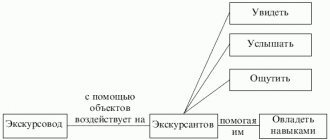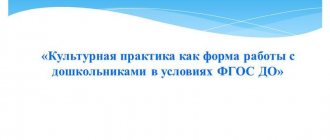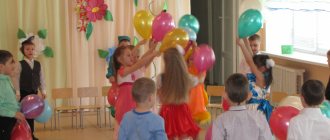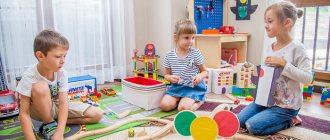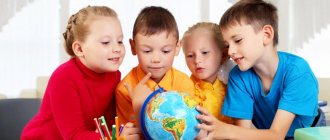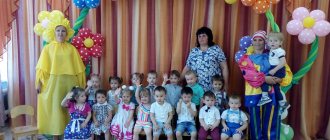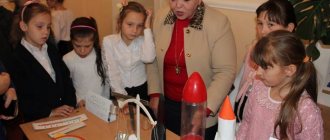Progress of the experiment:
Let's pour water into the container - it's a river. Then add oil to form a clearly visible film - “oil from a tanker”
What happens if you cover an aquarium with fish with plastic wrap? (the fish will die, because the film does not allow air to pass through and the fish cannot breathe. So the oil film does not allow air to pass through, fish and other inhabitants of water bodies die.
Let's purify the water without mixing it through a straw (let the children try to pour the oil over the edge, scoop it out with a spoon)
.
Remove the clothespin from the tube and pour the water into a placed jar; when an oily layer appears, clamp the tube with the clothespin. As a result, there will be clean water in the jar, and the oil will remain in the container.
Is it possible to drain the river too? How many people and time does it take to purify water? Will fish be able to survive all this time without air?
Conclusion. An oil spill poses a serious threat to wildlife.
"Birds and Oil"
The purpose of the experiment : to help children understand how oil pollution of water bodies affects waterfowl.
Material: downy bird feathers, any liquid oil (vegetable)
Children's experimentation in environmental education of preschool children. - presentation
Children's experimentation in environmental education of preschoolers
Types of experiments By object of study By object of study With inanimate nature With plants With animals With the characteristics of the human body
By number of children Frontal Frontal Subgroup Subgroup Individual Individual
According to methodological techniques Demonstration Demonstration Independent Independent
Statement of the problem problem Analysis of the problem. Proposing hypotheses Searching for methods of testing a hypothesis Search actions Understanding the results Conclusions
Problem task The teacher can suggest (after studying the interests of children, based on the program) The teacher can suggest (after studying the interests of children, based on the program) The children can suggest (in the process of play, work or educational activities) The children can offer (in the process of play, work or educational activities) activity) Should be in the child’s zone of proximal development (not too simple and not too complex) be in the child’s zone of proximal development (not too simple and not too complex) Be interesting to children Be interesting to children
Analyzing the problem Making hypotheses What do we know about it? What do we know about this? What do we want to know? What do we want to know? Options for answering the task question. Options for answering the task question. It is very important to involve all children in the discussion; to involve all children in the discussion; in no case should you evaluate the children’s answers (well done, right, wrong, etc.) in no case should you evaluate the children’s answers (well done, right, wrong, etc. .p.) Friendly, emotional atmosphere
Techniques for testing hypotheses Heuristic conversation (if children have enough knowledge) Heuristic conversation (if children have enough knowledge) Long-term observations (of the growth and development of plants, the behavior of animals, etc.) Long-term observations (of the growth and development of plants, behavior animals, etc.) Elementary experiments Elementary experiments
Search actions or the experience itself Must be safe for children and objects of experience Must be safe for children and objects of experience You should not prohibit children from speaking out their actions You should not prohibit children from pronouncing your actions Children have the right to make mistakes Children have the right to make mistakes Use ready-made sketches of the experiment algorithm Use ready-made sketches of the experiment algorithm
Making sense of the results What did we want to know? What did we want to know? What have we learned? What have we learned? How did we know this? How did we know this? Were our assumptions justified? Were our assumptions justified?
Conclusions The children themselves must make The children themselves must draw The wording is very brief and clear The wording is very short and clear If children draw incorrect conclusions or doubt, the experiment must be repeated according to the same structure. If children make incorrect conclusions or have doubts, the experiment must be repeated according to the same structure.
Organization of environmental observations and experiments with older preschoolers in preschool educational institutions
Bibliographic description:
Dorokhova, I. A. Organization of environmental observations and experiments with older preschool children in preschool educational institutions / I. A. Dorokhova, N. R. Trifonova, S. Yu. Lomakina, A. R. Ivannikova. — Text: immediate // Current issues of modern pedagogy: materials of the X International. scientific conf. (Samara, March 2022). - Samara: ASGARD Publishing House LLC, 2022. - P. 35-38. — URL: https://moluch.ru/conf/ped/archive/212/11902/ (access date: 02/05/2022).
Pedagogical guidance of experimentation should be aimed at developing and improving the external senses and cultivating the process of ideas. The teacher must include in the ability to observe the memorization of what is observed, the ability to distinguish the essential from the less significant in the observed object or phenomenon, the skill of comparing some signs with others and the habit of drawing correct conclusions from them. In order for the organizational and methodological aspect of the experimental activity to be more focused and effective, the following general requirements can be included in it:
- selection of knowledge content;
- level of readiness of children (the need for a stock of specific ideas, factual knowledge about those phenomena and objects of nature that the experiment will be devoted to;
taking into account the spatial organization of observations;
selection of material for the experiment;
creation of a subject-development environment;
compliance with safety regulations (protecting the life and health of children);
- compliance with the structure of the experience organization.
Selection of knowledge content , the development of which through research and experimental activities is the most effective. Since visual-effective and visual-figurative forms of thinking predominate in preschool childhood, information about nature must be specially selected and adapted to the child’s age. Only then can the content of the material in elementary search and experimental activities be easily and consciously assimilated by children.
For example, you can select the most elementary and clearly expressed interdependencies:
establishing relationships between plants and their habitat: establishing the dependence of plant growth on heat, sunlight, moisture, fertilizer and other connections that are the most significant in the life of plants and are quite accessible to understanding and assimilation by children of senior preschool age;
- adaptive significance of animal behavior; establishing connections between the structural features of the animal’s organs and the nature of its functions, i.e., the corresponding elements of behavior
The studied inanimate object or phenomenon should appear to the child with a wide variety of properties, such as:
establishing connections between the state of water and air temperature;
establishing the protective properties of snow;
- determination of air properties, etc.
The success of preschoolers’ assimilation of the content of experimental activities, the development of interest and desire to participate in it, depends on the choice of forms of organization of experimentation and methodological techniques, which are described below.
Readiness level of children . Organizing experiments requires a certain level of readiness of children. It is necessary that preschoolers have a stock of specific ideas, factual information about those phenomena and objects that will be mastered by searching. Therefore, the tasks of the introductory stage of the experimental activity are based on previously carried out previous work. For example, before organizing experiments with snow to determine its properties and qualities, it is necessary to conduct observations on walks. Highlight the color of the snow, its density (loose), temperature sensations (cold); note what snow looks like in snowdrifts on a warm and frosty day, etc.
The readiness of preschoolers must include their compliance with the rules of behavior during research observations or experiments. The corresponding rules can be drawn up by teachers themselves.
For example:
- stand or sit at a certain distance from the observed living object; Do not frighten the animal with unnecessary movements, loud screams, etc.
- sit at a certain distance from objects involved in heating liquids in them;
do not touch the objects in question, do not put them in your mouth, without obtaining permission from the teacher;
work with objects (snow, ice, water, earth, etc.), using sanitary napkins, towels;
- maintain cleanliness and order in your workplace;
- consider the observed object in the sequence indicated by the teacher, etc.
Prepare children for experimentation using the usual methods:
organized observations in a corner of nature and on walks using basic search situations;
- logical construction of conversations about observed objects or natural phenomena (heuristic conversations);
organization of practical acquaintance with the properties of natural objects;
teaching children the skills of maintaining a special calendar of observations of the weather, the life of plants and animals;
reading fiction and educational literature;
conducting games: situational, TRIZ, didactic, etc.;
content analysis (the use of children's creativity: drawings, fairy tales, stories, riddles, poems composed by children).
If the above is observed, children's experimentation will be effective, its influence will be very noticeable on the mental development of the child.
Taking into account the spatial organization of observations , selecting material for experimentation. The pedagogical requirement for the spatial organization of observations during search activities and experimentation is that any natural object should be as accessible as possible for observation by every child. In each specific case, the teacher considers how many children can simultaneously participate in the observation, how to arrange them (arrange, seat) so that they perceive the observed object in the best possible way and carry out practical actions with it. The child must see the object himself and everything that happens to it, hear the sounds emanating from it, be able to feel its taste and smell. In cases where an object of nature can be touched or picked up, the child must have the opportunity for tactile-kinesthetic examination in order to feel the nature of the surface and the heaviness of the object. This is what is called - independently obtaining sensory information about an object. The more of our senses take part in the perception of any impression, the more firmly this impression is embedded in mechanical memory, the better it is preserved and the easier it is to remember [3, p. 14].
Selection of material for experimentation.
Better assimilation of knowledge, its strength, understanding of cause-and-effect relationships in nature, and increased children’s interest in experiments are facilitated by a well-thought-out selection of materials, equipment and other visual aids. Material is selected that is suitable for a variety of search and research situations, experiences, and experiments that contribute to the improvement of external sense organs and the development of the child’s cognitive sphere. The objects of study in experimental activities should be natural objects of nature: sand, earth, water, snow, ice, plants and their fruits, seeds, etc. Handouts should ideally be available for each child or at least for a selected group of children so that they could pick it up and examine it individually. Handouts for experiments are laid out in identical plastic sockets, cups and other lightweight utensils that are safe for children’s health.
Some theoretical provisions of the teacher’s story must be illustrated with drawings, photographs, diagrams and other illustrative visual material.
The experiment is carried out on a demonstration table so that children can equally well observe all the actions of the teacher from any place and see the results of a short-term experiment.
When organizing experiments with children, the teacher must verbally designate everything that the children see, but the word must follow the sensory perception. Only in this case does the child develop full-fledged knowledge and is able to meaningfully make inferences and conclusions.
Creation of a subject-development environment. Work on introducing experimentation must begin with the creation of a subject-development environment that would allow each child to develop his abilities and model the functional development of the child’s activity. Using the presented material to organize experiments in a subject-development environment will allow for the effective development of children's mental activity, enrichment of their feelings, expansion of interests and intelligence, and development of independence.
The technical means, equipment and devices necessary for setting up experiments can be brought into the subject environment. These can be microscopes, a room thermometer, a psychrometer (determines the degree of humidity), magnifying glasses, cones, collections of vegetable seeds and other planting material, various containers for storing natural objects (sand, earth, pebbles), wooden, plastic objects, toys, organic fertilizers (crushed egg shells, etc.)
All specified equipment must be safe for the health and life of the child.
It is recommended to place artistic material in the object environment: illustrated fairy tales, reproductions of paintings, crafts made from natural materials (heroes of fairy tales in the garden, etc.)
In the mini-laboratory you can place children's creativity products: drawings, written fairy tales, stories, riddles, diagnostic material, etc.
The activity-based approach should be the basis of the subject-development environment. Activity develops the psyche and ensures true creativity, while inactivity leads to a narrowing of the individual’s capabilities, to laziness of thought and body.
An important aspect in creating a subject-developing environment is the creation of ecological “spaces” for experiments: an experiment corner, mini-laboratories on the window, phytoglades [2, p. 136].
Each component of the development environment must meet the principle of functional comfort. All children should feel cozy, comfortable, and interesting. The subject environment should be available for children’s independent activities (playing with water, sand, pebbles; for experimental operations). Tools should be accessible to children. It must meet sanitary and hygienic standards and conditions for protecting the life and health of children.
Compliance with safety rules (protecting the life and health of children) The teacher takes measures to create healthy and safe conditions for conducting experiments. Ensures the safe condition of the subject environment, equipment, instruments, instruments and the sanitary condition of the premises. Does not allow experiments involving danger to health and life. Poisonous and thorny plants and chemical fertilizers are not allowed in kindergarten.
The teacher conducts safety briefings with children on the use of equipment and materials during demonstrations of experiments. Reinforces the rules of behavior when demonstrating experiments through the following forms and methods of teaching: workshops, conversations, business, didactic games, solving situational problems, using photo-illustrative material, etc.
Compliance with the structure of the experience organization.
- The beginning of preparing children for experimental work is the previous work. It includes familiarity with objects, bodies of inanimate nature, their properties, qualities, and significance for living organisms.
- Selection of object, equipment, materials for the experiment.
- Creating motivation for children to participate in experimentation. Choose a technique that will allow children to engage in intense mental work. The best are verbal and effective techniques that will help concentrate children's attention. An affectionate tone, intriguing intonation, a descriptive riddle, or an action riddle about the subject of observation.
- Setting goals and objectives; what they will do, what they will achieve. Experience is used as a way to solve a cognitive problem. The task can be put forward by the teacher together with the children. The task must be clearly formulated.
- Analysis of the state of the object. Definition of the problem.
- Discussion of forecast probability.
- Development of group norms and rules of behavior. Safety briefing.
- Organization of experience (experiment). In this part of the organization of experience, there is a process of explaining and showing the course of the experiment (experiment), a process of sensory examination, sequential examination of experimental material (water, earth, sand, plants and their fruits, and seeds, etc.), independent receipt of sensory information. The teacher shows and draws attention to the fact that all conditions must be equalized, and only one of them, which affects the result of the experiment, must be highlighted [1, p. 27]. It develops in children the ability to operate with the simplest formulations and methods of conducting experiments. The techniques used by the teacher at this moment should be bright and unusual, so that the examination itself does not seem boring. The teacher listens to the statements of most children. Confirms correct information, praises those who have found the correct answers, and encourages other students to take additional actions. Short, precise explanations and games with experimental material are possible, allowing one to consolidate the discovered properties and qualities of objects.
- In case of long-term experience (experimentation), it is advisable to distribute responsibilities between children according to services: activity (performing a practical function), analytical (observation function), diagnostic (recording the results of the experiment).
- Completion of the experience (experiment). Discussion of the results obtained. Children find the answer to the question posed and establish the cause of the observed phenomenon. They comprehend the patterns in the life of plants and consciously understand the causes of many phenomena (why does it rain, snow?), etc. Conclusions, conclusions. Summing up, assessing children's activities.
- Preparation of diagnostic materials (diagrams, tables, diagrams, graphs, drawings).
- Arrangement of an exhibition with visual materials accompanying experimental activities.
- Conducting leisure activities, holidays, such as “Erudic Day”, “What do we know about the sprout?”, including a generalization of experience in research, experimental work with preschoolers, etc.
Carrying out experimental work in accordance with the specified requirements is possible only if the teacher is specially prepared for it in terms of the content and organization of the experiment, the time and place of the experiment, the number of children who can participate in it at the same time, and methodological techniques.
The presented structure for organizing experimental activities will help the teacher competently plan experimental activities with older preschoolers in the daily routine of preschool education, and achieve an overall positive pedagogical effect.
Literature:
- Ivanova, A. I. Methodology for organizing environmental observations and experiments in kindergarten [Text]: a methodological manual for workers of preschool institutions / A. I. Ivanova. - Novokuznetsk: IPK Publishing House, 1999. - 56 p.
- Nikolaeva, S. N. Theory and methodology of environmental education for children [Text]: Textbook for students. higher ped. textbook establishments /S. N. Nikolaeva. - M.: Publishing House, 2002. - 336 p. 46.
- Ryzhova L.V. Methods of children's experimentation [Text]: a book for teachers and parents /L. V. Ryzhova. — Anzhero-Sudzhensky urban district, MBOU DOD “DEBTs im. G. N. Sagil", 2013. - 221 p.
Basic terms
(automatically generated)
: experimental activity, subject-development environment, child, children's health, teacher, safety technician, plant life, material selection, spatial organization of observations, experimental activity.
